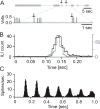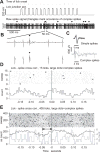Cerebellar cortical output encodes temporal aspects of rhythmic licking movements and is necessary for normal licking frequency
- PMID: 20597972
- PMCID: PMC4454453
- DOI: 10.1111/j.1460-9568.2010.07244.x
Cerebellar cortical output encodes temporal aspects of rhythmic licking movements and is necessary for normal licking frequency
Abstract
Rodents consume water by performing stereotypic, rhythmic licking movements that are believed to be controlled by brainstem pattern-generating circuits. Previous work has shown that synchronized population activity of inferior olive neurons was phase-locked to the licking rhythm in rats, suggesting a cerebellar involvement in temporal aspects of licking behavior. However, what role the cerebellum has in licking behavior and whether licking is represented in the high-frequency simple spike output of Purkinje cells remains unknown. We recorded Purkinje cell simple and complex spike activity in awake mice during licking, and determined the behavioral consequences of loss of cerebellar function. Mouse cerebellar cortex contained a multifaceted representation of licking behavior encoded in the simple spike activities of Purkinje cells distributed across Crus I, Crus II and lobus simplex of the right cerebellar hemisphere. Lick-related Purkinje cell simple spike activity was modulated rhythmically, phase-locked to the lick rhythm, or non-rhythmically. A subpopulation of lick-related Purkinje cells differentially represented lick interval duration in their simple spike activity. Surgical removal of the cerebellum or temporary pharmacological inactivation of the cerebellar nuclei significantly slowed the licking frequency. Fluid licking was also less efficient in mice with impaired cerebellar function, indicated by a significant decline in the volume per lick fluid intake. The gross licking movement appeared unaffected. Our results suggest a cerebellar role in modulating the frequency of the central pattern-generating circuits controlling fluid licking and in the fine coordination of licking, while contributing little to the coordination of the gross licking movement.
Figures







Similar articles
-
Behavior-related pauses in simple-spike activity of mouse Purkinje cells are linked to spike rate modulation.J Neurosci. 2012 Jun 20;32(25):8678-85. doi: 10.1523/JNEUROSCI.4969-11.2012. J Neurosci. 2012. PMID: 22723707 Free PMC article.
-
Cerebellar control of targeted tongue movements.J Physiol. 2025 Mar;603(5):1141-1169. doi: 10.1113/JP287732. Epub 2025 Jan 26. J Physiol. 2025. PMID: 40019494 Free PMC article.
-
Movement Rate Is Encoded and Influenced by Widespread, Coherent Activity of Cerebellar Molecular Layer Interneurons.J Neurosci. 2017 May 3;37(18):4751-4765. doi: 10.1523/JNEUROSCI.0534-17.2017. Epub 2017 Apr 7. J Neurosci. 2017. PMID: 28389475 Free PMC article.
-
Licking behavior in the rat: measurement and situational control of licking frequency.Neurosci Biobehav Rev. 1998 Oct;22(6):751-60. doi: 10.1016/s0149-7634(98)00003-7. Neurosci Biobehav Rev. 1998. PMID: 9809310 Review.
-
Fast oscillation in the cerebellar cortex of calcium binding protein-deficient mice: a new sensorimotor arrest rhythm.Prog Brain Res. 2005;148:165-80. doi: 10.1016/S0079-6123(04)48014-5. Prog Brain Res. 2005. PMID: 15661189 Review.
Cited by
-
Effects of thioTEPA chemotherapy on cognition and motor coordination.Synapse. 2019 Jun;73(6):e22085. doi: 10.1002/syn.22085. Epub 2019 Mar 14. Synapse. 2019. PMID: 30586195 Free PMC article.
-
Circuits in the rodent brainstem that control whisking in concert with other orofacial motor actions.Neuroscience. 2018 Jan 1;368:152-170. doi: 10.1016/j.neuroscience.2017.08.034. Epub 2017 Aug 23. Neuroscience. 2018. PMID: 28843993 Free PMC article. Review.
-
Cerebellar Purkinje Cells Generate Highly Correlated Spontaneous Slow-Rate Fluctuations.Front Neural Circuits. 2017 Sep 20;11:67. doi: 10.3389/fncir.2017.00067. eCollection 2017. Front Neural Circuits. 2017. PMID: 28979195 Free PMC article.
-
Association of dysphagia with altered brain glucose metabolism in Parkinson's disease.CNS Neurosci Ther. 2023 Sep;29(9):2498-2507. doi: 10.1111/cns.14214. Epub 2023 Apr 11. CNS Neurosci Ther. 2023. PMID: 37041694 Free PMC article.
-
Decreased home cage movement and oromotor impairments in adult Fmr1-KO mice.Genes Brain Behav. 2017 Jun;16(5):564-573. doi: 10.1111/gbb.12374. Epub 2017 Mar 29. Genes Brain Behav. 2017. PMID: 28218824 Free PMC article.
References
-
- Albus JS. A theory of cerebellar function. Mathematical Biosci. 1971;10:25–61.
-
- Asanuma C, Thach WT, Jones EG. Brainstem and spinal projections of the deep cerebellar nuclei in the monkey, with observations on the brainstem projections of the dorsal column nuclei. Brain Res. 1983;286:299–322. - PubMed
-
- Boughter JD, Baird JD, Bryant JL, St John SJ, Heck DH. C57BL/6J and DBA/2J Mice Vary in Lick rate and Ingestive Microstructure. Genes, Brain and Behavior. 2007;6:619–627. - PubMed
-
- Boyden ES, Katoh A, Raymond JL. Cerebellum-dependent learning: the role of multiple plasticity mechanisms. Annu Rev Neurosci. 2004;27:581–609. - PubMed
Publication types
MeSH terms
Grants and funding
LinkOut - more resources
Full Text Sources

